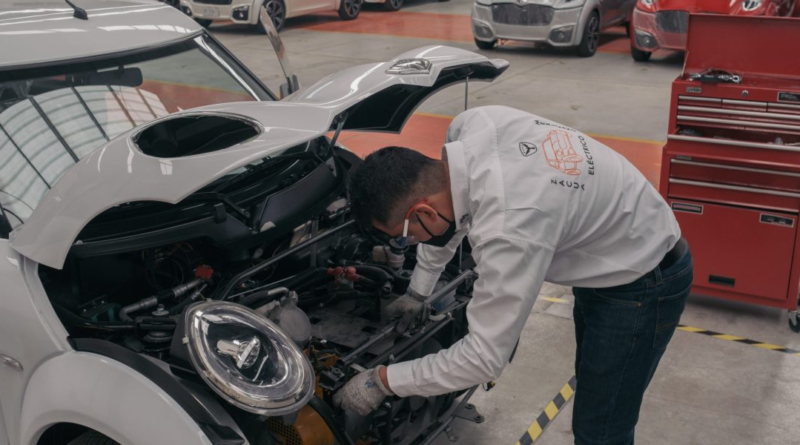Mexico is set to be the big winner of the EV revolution—but it has a key challenge to overcome first
The electric vehicle market is exploding worldwide. By 2030, the International Energy Agency predicts, EVs will represent 60% of all vehicle sales globally. And in the U.S., despite total vehicle sales dropping 8% year over year in 2022, sales of EVs jumped 65%, according to data from Kelley Blue Book. Although countries like China have grabbed headlines in the EV race, the biggest beneficiary of all that expansion might be Mexico.
“Mexico has unique advantages that could help solidify its position in the automaking industry amid the EV transition,” UBS’s Alejo Czerwonko, chief investment officer for emerging markets Americas, and Gabriela Soni, CIO for Mexico, explained in a Thursday note.
Mexico has the world’s 10th-largest store of lithium, which is a key component used in EV batteries that is commonly referred to as the industry’s “white gold.” And the country’s current auto manufacturing strength, coupled with an increase in nearshoring—where manufacturers rework supply chains closer to home—after pandemic-era supply-chain mishaps, is likely to make it an EV powerhouse in the future, Czerwonko and Soni said.
But the pair were also careful to warn that Mexico’s EV success is not guaranteed, and that it “faces a long road ahead” owing to one key factor: a lack of energy infrastructure necessary to go all in on EV manufacturing.
Serious EV advantages
Mexico is already the fourth-largest exporter and seventh-largest producer of cars globally, and hosts a number of big-name automakers, including Toyota, Kia, Volkswagen, and Nissan. Ford even produces its Mustang Mach-E EV at the Cuautitlán Stamping and Assembly Plant in Cuautitlán Izcalli, about 20 miles outside Mexico City.
Multiple automakers have also recently announced moves into Mexico to produce EVs. General Motors said last year it will build the 2024 Blazer EV and Equinox EV at its factory in Ramos Arizpe, a city in the northern state of Coahuila. BMW said just last month that it will invest $866 million into EV production in the country. And Tesla announced plans last week for a $5 billion gigafactory in Monterrey, Nuevo León, about 120 miles from the U.S. border.
Local officials have said that the 4,200-acre site is nearly double the size of the EV giant’s Texas facility.
“This is a game changer for a transition from traditional industry to an industry of the future, a green industry,” Nuevo León Gov. Samuel Garcia said Friday, adding that it could lead to $10 billion in total investment into his state in the coming years, Bloomberg reported.
Czerwonko and Soni called Tesla’s move “a vote of confidence in Mexico’s auto manufacturing industry and its hopes of gaining market share in the global electric vehicle (EV) space,” and noted it’s just one of many data points that demonstrate Mexico is already benefiting from nearshoring. Through the first nine months of 2022, direct foreign investment into Mexico increased by 29.5%, the most since 1999, according to data from Mexico’s Confederation of the National Chambers of Commerce (CONCANACO).
The energy challenge
Despite all its advantages, however, a lack of stable energy infrastructure is a problem when it comes to EV production in Mexico. EV production facilities are incredibly energy intensive as are the vehicles they produce.
UBS’s Czerwonko and Soni said that energy availability is a major source of concern for them given Mexico’s reliance on fossil fuels and frequent power outages. Mexico is aware of the problem, and Secretary of Foreign Affairs Marcelo Ebrard said last month that he will support multiple manufacturing hubs for EVs in the country by building five huge solar plants to produce five gigawatts of energy capacity. He told Reuters that he was hoping to attract all the foreign investors he could with the project, noting that BMW, Audi, GM, Fiat Chrysler, and, of course, Tesla had all expressed interest in producing EVs in the country.
“Big questions remain about the financing of such an ambitious plan, as well as the efficiency and operational management capability of the state-owned power company to deploy an investment of such scale,” UBS’s Czerwonko and Soni cautioned, arguing “significant additional investment is required to develop Mexico’s renewable energy sources.”
The UBS team noted that Mexico hopes to get funding for its energy project through the North American Development Bank (NADB), which was created by the governments of Mexico and the U.S. to help finance infrastructure projects. But that’s not a sure thing.
“It seems unlikely that the NADB would provide the amount of resources that the Mexican government needs. Hence, the plan will likely require a mix of private, public, and development bank funding,” they warned.
Planning for the future
Still, the Mexican state electric utility CFE has already begun work on its first solar plant, which will be the largest in all of Latin America, in the northern state of Sonora. The government also plans to expand its total renewable energy capacity to 30 gigawatts by 2030.
Mexican President Andrés Manuel López Obrador nationalized the production of lithium in 2022 as well, and set up a state-owned company called LitioMx to manage its exploration, mining, and refinement last month hoping to attract foreign investors. The company is already in talks with Canadian lithium miner Advanced Lithium to mine the metal for EV battery production, Reuters reported Thursday.
Czerwonko and Soni said that, overall, they believe that Mexico can “capture the emerging EV opportunity,” as long as public-private partnerships function as intended.
Learn how to navigate and strengthen trust in your business with The Trust Factor, a weekly newsletter examining what leaders need to succeed. Sign up here.




